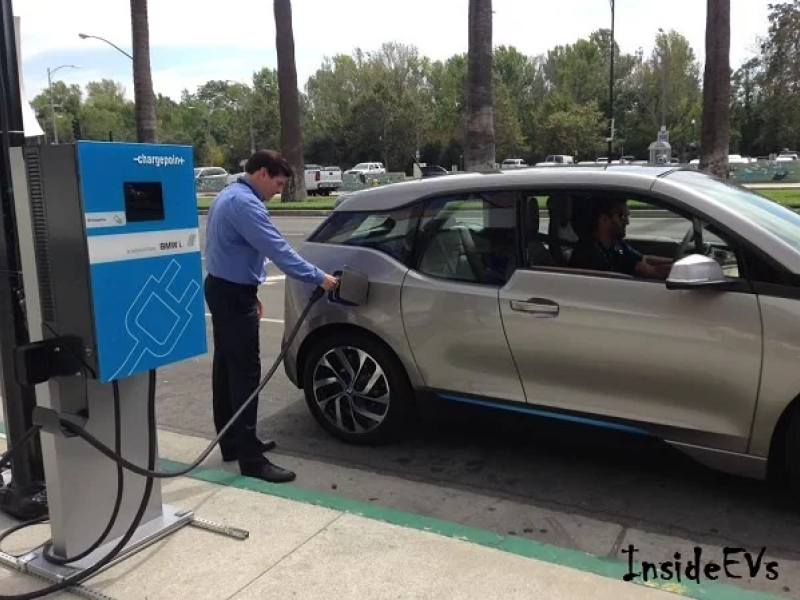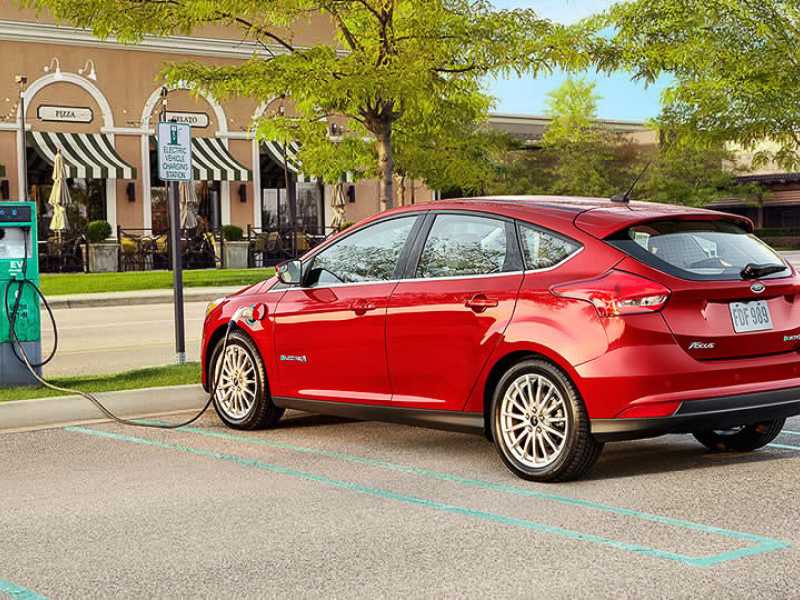Most electric vehicle (EV) drivers charge at home because it's cheap and convenient. For travelers, on-street parkers, and people who live in apartments and condos, public charging is increasingly available, especially in workplaces. You might be surprised to learn that there's charging near you that you haven't noticed! There are also lots of incentives to help you install charging at home.
Charging At Home
If you charge your EV at home, you have two options: Level I or Level II charging. (For a review of the different types of charging, please see our Charging Basics page.) For Level I charging, you simply take the cord that comes with the vehicle and plug it into an existing 120-Volt outlet, which adds about 4 miles per hour spent charging. Though this is the slowest type of home charging, it works well for many drivers. If you can charge at home overnight, you can recoup 40 miles of daily driving in 10 hours while you sleep.
If you want to charge faster, you have the option of installing a Level II charging unit, which requires a 240-Volt outlet. Level II charging stations are installed by licensed electricians, and they cost a few hundred dollars at a home improvements store or online, plus the cost of the electrician's time. There are “dumb” chargers, which are essentially just safety equipment, and “smart” chargers, which are WiFi-enabled and allow you to see and schedule charging online. There are also portable Level II chargers, which are simply sophisticated charging cords that you can plug directly into a 240-Volt outlet on one end and the vehicle on the other.
The process and incentives for installing charging differ depending on whether you live in a single-family home or in an apartment or condo.
Charging at Single Family Homes
If you're thinking about installing a Level II charging unit at home, it can be tricky to know where to start. We've written a guide to walk you through the process and make it as easy as possible for you to transition from gasoline to electricity. Check it out to get help with...
- Determining your charging needs
- Picking a charging station
- Preparing your home's electrical system for installation
Charging at Apartments & Condos

A Guide to installing charging at apartments & condos
More and more residential communities are installing charging stations for their residents thanks to incentives offered by state and utility programs. However, if you want to drive an EV and live in an apartment or condo without charging available, it can be challenging to motivate the relevant decision-makers to prioritize EV charging. To add more difficulty to the situation, apartments and condos come in all sorts of shapes, sizes, and parking arrangements, which means there’s no one-size-fits-all solution to install charging if you live in a multi-unit building.
The good news is that you can help put EV charging on the radar of your community, and we have resources to help you. Our guide to installing charging at apartments & condos will prepare you to have an informed conversation with your neighbors, property managers, or condo association so that you can put EV charging on the priority list.
Our guide answers questions like:
- How will users pay for shared charging stations in a lot with unassigned parking?
- Where can you get expert advice on incentives, site design, and other key planning considerations?
Charging on the go

Public Level II Charging
When you are away from home, you can access an increasing number of public charging stations. It’s easy to find these stations with cell phone apps and some new EVs come with these apps right on the dashboard display.
Plus, there are several websites to help you find charging stations near your home or workplace:
You can also ask your employer about workplace charging and encourage them to take advantage of federal and Massachusetts state incentives and programs.

Public DC Fast Charging
45-200 miles per 30 min
This charging option is capable of adding significant range to an EV for road trips or emergencies. DC fast charging speeds vary widely according to differences in ambient temperature, battery state-of-charge, station power, and vehicle model and year.
Most modern EVs can be equipped with DC quick charge capability via an additional charging port on your onboard charger. Some come with a DC Fast Charging port automatically and some require you to purchase a special package. You can compare DC Fast Charging speeds by vehicle model and station power here.
Many drivers are concerned about where EVs can charge other than at home; this issue is especially pressing for those who park on the street, rent, or live in a building where charging is not accessible from a parking spot. The good news is that Massachusetts and Rhode Island have more public stations than most people realize, and more are being built all the time. Since charging stations are often hidden from view, the best way to find them is via smartphone apps. Plugshare and A Better Route Planner are two of the most popular mapping tools in New England. Many EVs also come with in-car navigation help you find charging stations along your route.
Below is an interactive map from PlugShare:
Managed Charging
It is becoming more commonplace for electric utility companies to offer smart charging programs to encourage EV drivers to charge at times that are best for the electric grid and most environmentally friendly.
No matter when you charge your electric car, it's a good thing for the environment. Right now, an EV in New England causes emissions that are just one fourth of what you get from burning petroleum-based fuels in a combustion engine. And the emissions are going down each year thanks to state renewable energy mandate. We consumers currently pay a flat retail fee per kilowatt-hour (kWh) of electricity that is already cheaper per mile than driving on gasoline. However, the actual cost to the grid of bringing power to you to charge your car (or your phone, for that matter) varies over time. Costs are high when demand is high: for example, in the winter when lights are on at home and work, or in the summer when ACs are blasting. Conversely, costs are low when demand is low: for example, at 2 am when we’re all asleep on a cool evening. Demand is almost always low on the weekends.
Consequently, we can add to the stack of benefits by charging our EVs at the right times, i.e. when electricity is cheapest and cleanest. “Smart charging” is possible because EVs are not your typical home appliance; their charging time is flexible. For example, running the vacuum at 3 am isn’t feasible, but charging an EV is; they’re parked the majority of the time and power prices are almost always very low when you are asleep!
Many utilities across the country try to encourage “smart” charging behavior by offering discounted rates for off-peak charging or by directly ramping down the power consumed by EVs.
Here's what's available in Massachusetts:
- National Grid Charge Smart: All participants receive a $50 enrollment bonus plus rebates off every kilowatt-hour (kWh) of charging during off-peak hours. From 9pm to 1pm on weekdays, the rebate is $0.03/kWh in non-summer months (Oct.1-May 31) and $0.05/kWh in summer months (Jun. 1-Sep. 30). The rebates will be seen on monthly electric bills.
Here's what's available in Rhode Island:
- Rhode Island Energy EV Demand Response (EVDR) program: Participants receive $50 for enrollment and $20 at the end of the season for reducing their EV energy use during peak grid events. Peak events are between 3-8pm during the summer and the season runs through the summer months. There are a maximum of 60 demand response events per season. Participants are notified of peak energy events and RI Energy manages their energy use during these events. EVs still reach a full charge, albeit at a slower rate. Participants can opt out of an event or withdraw from the program at any time. For more information, check here.